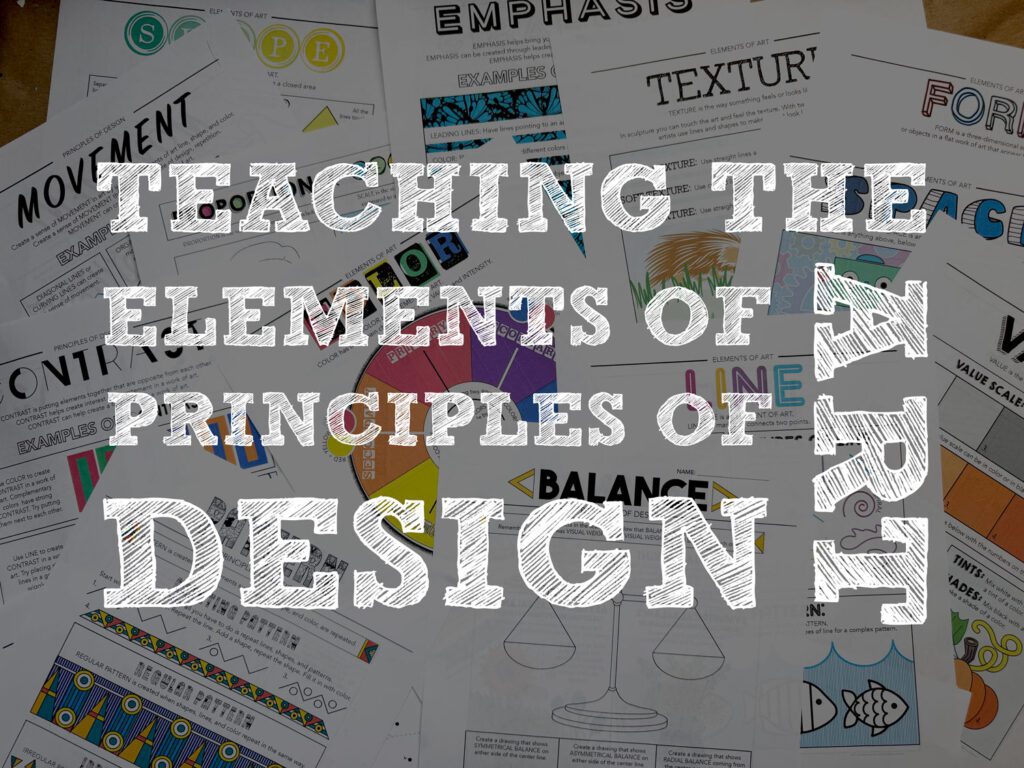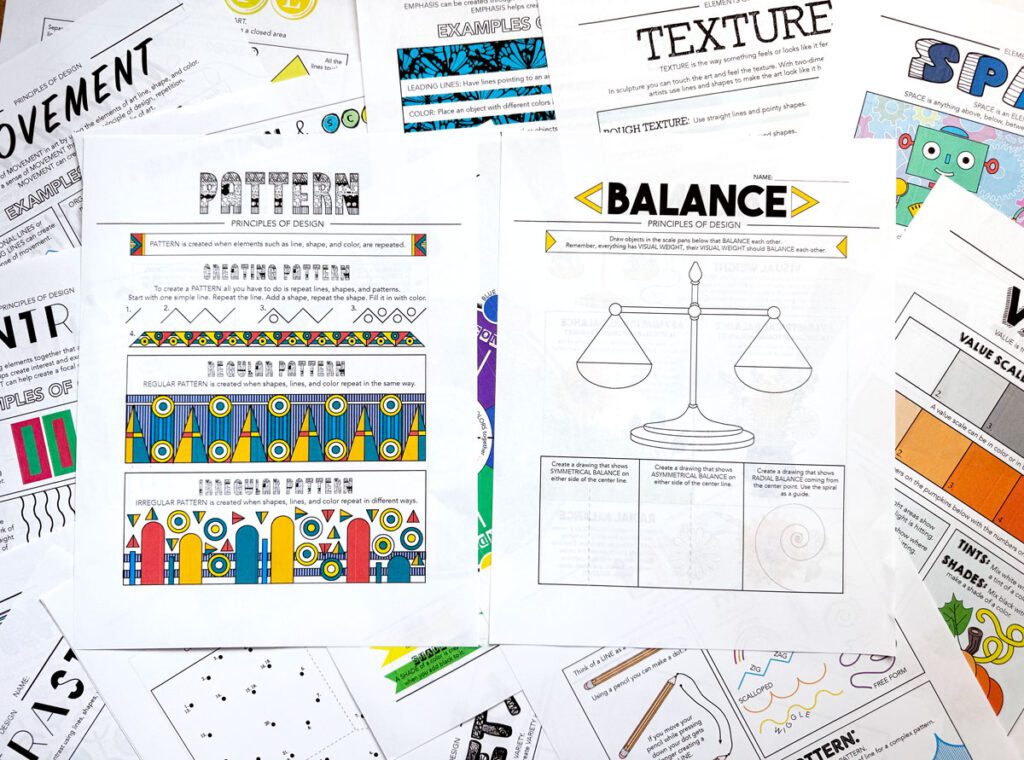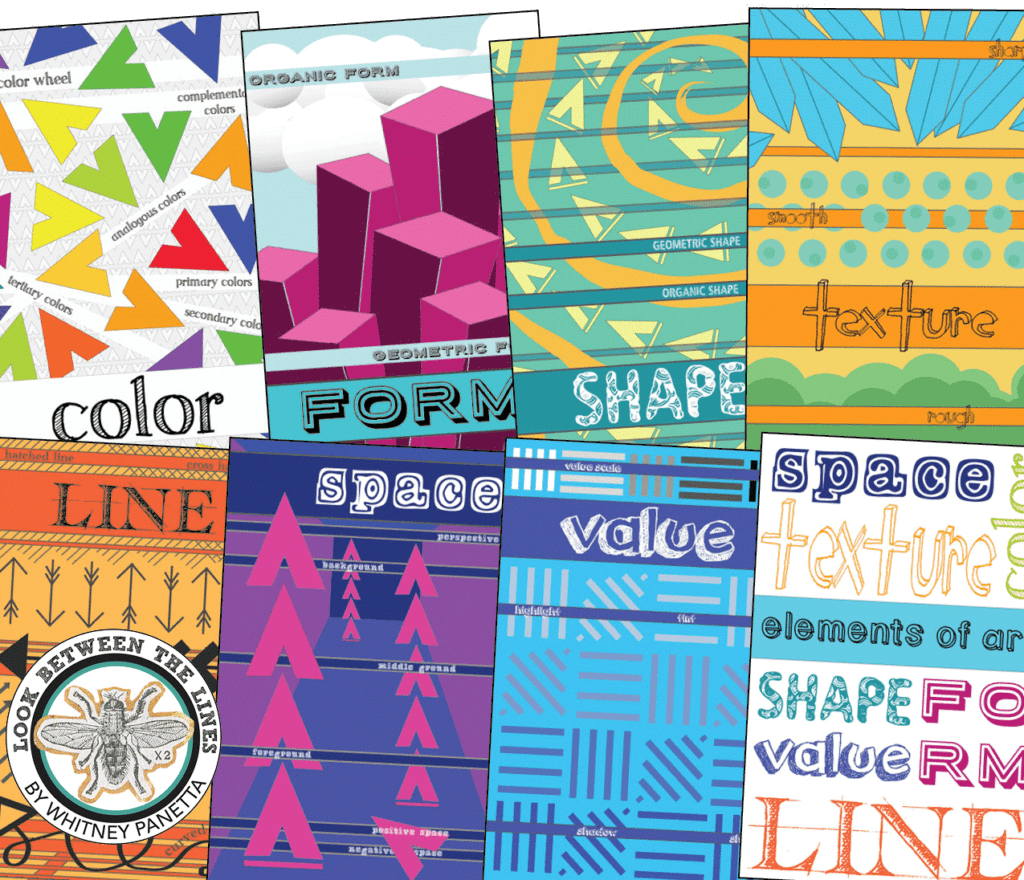
The elements of art and principles of design are the backbone of any art program. These are important vocabulary words and techniques to teach to students at any level. However, the foundation needs to be laid in elementary art. In middle and high school art classes these concepts are continuously reviewed and built on top of. Which is why it’s important to make this the focus in elementary art to help students be successful in future art programs.
Check out ways I incorporate the elements of art and principles of design into my classes plus tips from my retired art teacher mom on how she used them in her elementary art classes.
STRUCTURING YOUR CURRICULUM:

Before the school year begins, it’s helpful to outline your curriculum with key concepts you intend to teach, such as watercolor techniques and mixed media. Using the elements of art (line, shape, color, texture, form, space, value) and principles of design (balance, contrast, emphasis, movement, pattern, repetition, rhythm, unity, variety) as a guiding framework helps scaffold lessons and provides a clear structure for the year.
For example, in an upper elementary or middle school curriculum, you might start with basic drawing techniques and concepts like line and contour drawing. As the year progresses, introduce color theory and painting, and then delve into more complex principles like balance, variety, and focal point through advanced painting, collage, and mixed media projects. Check out my middle school art curriculum to see how I began with techniques, and then assign an element and principle to every project to ensure I covered all of them.
My mother, a retired elementary art teacher, also used the elements and principles as the backbone of her K-5 curriculum. She started with basic elements like line, shape, and texture, gradually incorporating principles of design as students mastered each element. This approach ensures that students continuously build on their knowledge, reinforcing and integrating these concepts throughout their projects.
FIRST DAY REVIEW

The initial weeks of the school year can be chaotic, with students adjusting to new routines and schedules. Keeping activities simple and low-stress is key. A great way to start is by reviewing the elements of art and principles of design. Assign each grade level an element to create a poster about using basic supplies like pencils, colored pencils, markers, and crayons. These student-created posters can serve as visual references throughout the year and add a personal touch to your classroom decor.
Read more tips for preparing for the first day in elementary art here.
TEACHING THEM THROUGHOUT THE YEAR

Incorporating the elements of art and principles of design into your curriculum can happen naturally if you use them as the foundation for your lessons. Besides focusing on them in major projects, consider integrating them into warm-up activities and fast-finisher tasks. Keeping students engaged with these concepts helps reinforce their understanding and application.
One effective classroom management strategy is to have a variety of fast-finisher activities on hand. My favorite is an elements of art and principles of design activity pack, which includes independent, student-directed tasks that are more than just busy work. These activities keep idle hands busy and reinforce the vocabulary and concepts being taught. Check out my elements of art and principles of design activity pack designed for elementary art students here.
VISUAL DISPLAYS IN THE CLASSROOM

Visual aids are invaluable in an art classroom. Hanging posters that focus on the elements of art and principles of design not only decorate your room but also provide easy reference points for students. These displays can reinforce the lessons and serve as constant visual reminders of the core concepts they are learning.
By thoughtfully integrating the elements of art and principles of design into your curriculum, you create a solid foundation for your students’ artistic growth. This approach not only helps organize your teaching year but also builds a strong base of knowledge that students will draw on as they advance in their art education.
You can get this element of art poster pack for free here!
Check Out More Tips
For additional ways to incorporate the elements of art and principles of design into your classroom, plus tips from my retired art teacher mom, stay tuned to this blog. We’ll explore more hands-on activities, project ideas, and classroom management strategies to make your art room a vibrant and productive learning space.
Don’t forget to follow me on Instagram and TikTok for weekly visual journal demos and other project ideas. Subscribe here to get freebies, project tutorials, and more straight to your inbox. Until next time!

Looking forward to using your principles of design and element.
I hope it goes well! Reach out if you have any questions and good luck!